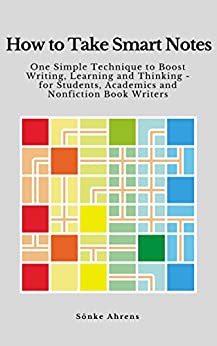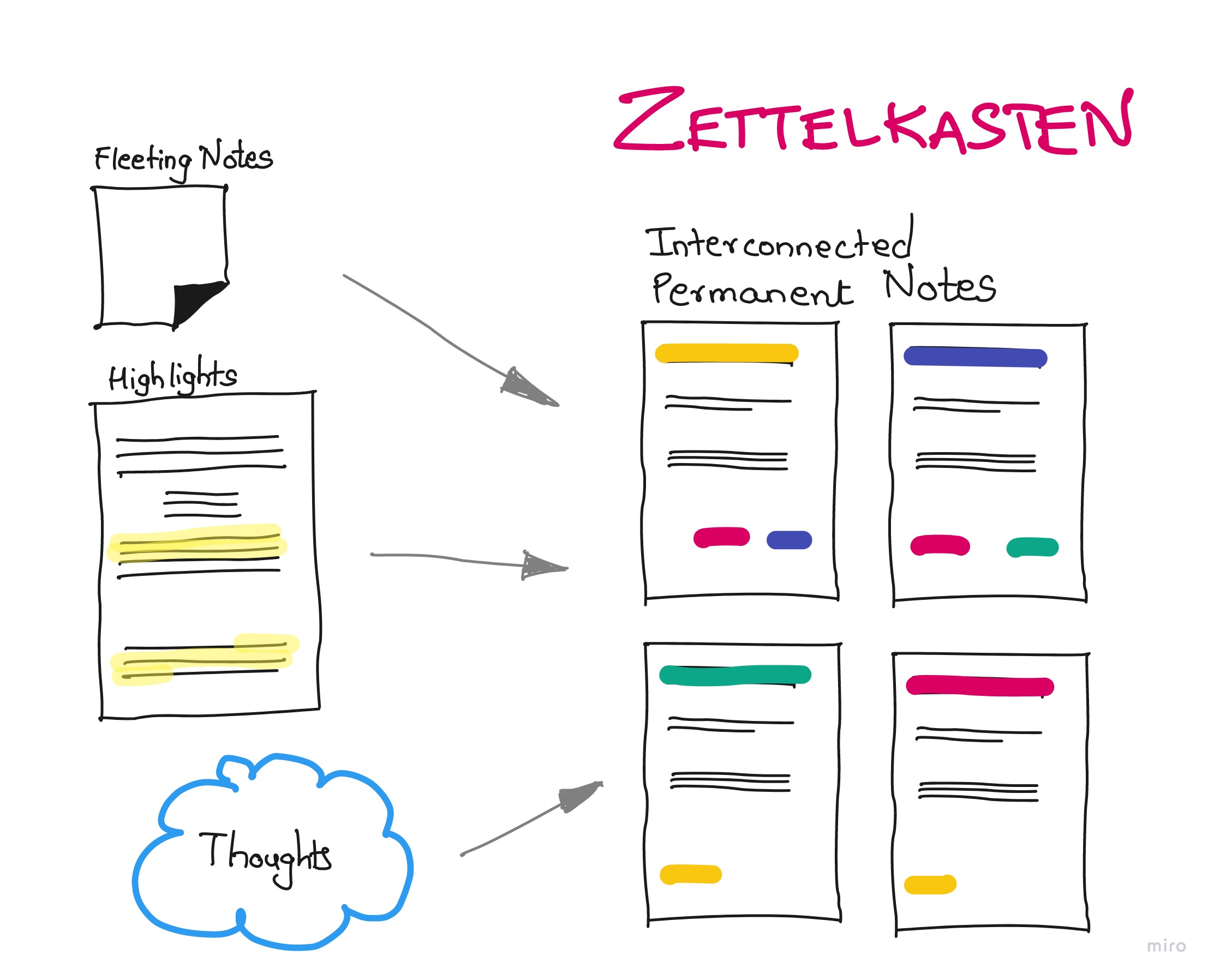How to Take Smart Notes
Key Ideas
Generating insights is key to accelerate research and learning. To generate insights, Ahrens recommends using the Zettelkasten method to create a Second Brain that helps see relationships between concepts, discover open holes, and validate or invalidate understanding.
Read by taking notes and noting concepts in your own words. This process helps deepen our understanding.

Details
How do you plan for insight, which, by definition, cannot be anticipated?
Ahrens’s book, while directed at students and researchers, is applicable to everyone that cares about learning new things.
To generate more insights, Ahrens recommends changing the learning workflow. Reading alone is insufficient and having read more does not mean more ideas.
Zettelkasten system to store and connect ideas
The Zettelkasten system relies on a series of interconnected notes. The original system was built using pen and paper by Niklas Luhmann. He relied on writing notes that were organized by topic, putting physical pieces of paper next to each other in a slip-box. Each piece of paper also had linkages to other notes. He relied upon these linkages to generate insight and connect one thing to another.

Replicating the system today is easier, thanks to technology.
Fleeting Notes
The first step is to capture all your ideas - whether they’re coming from things you read, or during a shower, or on a walk, or when you’re browsing the internet. Use whatever means you’d like to capture fleeting notes - pen and paper, voice memos, apps on your devices.
When reading books and articles, I find it particularly easy to highlight things – Kindle makes it very easy to highlight things, as well as revisit all highlighted content. Importantly, the act of highlighting is insufficient. Treat highlights as another fleeting note.
I also use Notion to maintain a web reading queue. Alternatives include browser bookmarks, Pocket and Instapaper.
Permanent Notes
All forms of fleeting notes can be converted to permanent notes, though not all should. There are plenty of fleeting notes that weren’t great ideas or didn’t generate any particular value, and can be discarded.
Permanent notes require more thought to put together and are short summaries of fleeting notes. I use Roam Research, though Obsidian is a very reasonable alternative.
Links
Linking permanent notes together is an extremely important step. Tools like Roam Research allow you to very easily link permanent notes together. Moreover, they automatically generate backlinks and maintain your link graph.
You can use a tag scheme to link notes together, however, be cautious. An Archivist tags notes to figure out where to store them. A Researcher tags notes to figure out how to retrieve them. As yourself the question: In what circumstances will I want to stumble upon this note, even if I forget about it?
GTD vs. Insightful Writing
David Allen’s Getting Things Done system is an excellent way to be productive. The central insight in GTD is to collect everything in one place and process it in a standard way. This system forces clear prioritization and continuously evaluates how tasks fit into the bigger picture.
GTD is different from Insightful Writing (Ahrens’s method). They are hard to combine – for GTD to work, you must know where you’re trying to go (clear objective) and the path can be decomposed into smaller steps that guarantee progress. Research, writing, and insight generation are not linear and we have to constantly jump back and forth between tasks.
Learn by Writing
If you want to learn something for the long run, you have to write it down.
Write with a slip-box. Develop topics, questions, and research projects from the bottom up within the system. Turn the permanent notes into a rough draft. You should be able to see the holes in the argument and do more research.
Read by Writing
Take Notes
I would advise you to read with a pen in your hand and enter in a little book short hints of what you feel that is common or that may be useful; for this will be the best method of imprinting such portcullis in your memory. – Benjamin Franklin
Be careful about Confirmation Bias. We are often seeking supporting evidence instead of reading with an open mind to truly understand. Darwin’s technique for avoiding confirmation bias was to force himself to write down and elaborate upon the argument that were the most critical of his theories.
Get the gist. Summarize and pull out only the most important bits.
Anti-Brainstorming
Brainstorming is an old technique, introduced to the world in 1958. It tests for memorized knowledge, without much indication of insight. Someone can come up with a lot of ideas during brainstorming sessions but give no indication about their quality. Brain prioritizes ideas that are easily available, not the best or the most relevant. The brain also remembers things that have happened more recently. Things that are abstract or vague get pushed down the list. Additionally we love our own ideas and get wedded to them pretty quickly. Prefer the bottom-up, deliberate approach to generating ideas and insights to a “brainstorm”.